ASUS ROG Rampage Formula: Why we were wrong about the Intel X48
by Kris Boughton on January 25, 2008 4:30 AM EST- Posted in
- Motherboards
BIOS Screenshots and Interesting Settings

ASUS boards are known for their high level of customization and the Rampage Formula is no exception. The main menu that provides a majority of the options normally associated with overclocking is renamed "Extreme Tweaker", which we feel is entirely appropriate. Users can adjust everything from here, from bus speeds to voltages and memory timings to MCH parameters. Although a few options with indeterminate purposes still exist (for example, "Ai Clock Twister"), for the most part ASUS has done an excellent job in clearly labeling what each setting does.
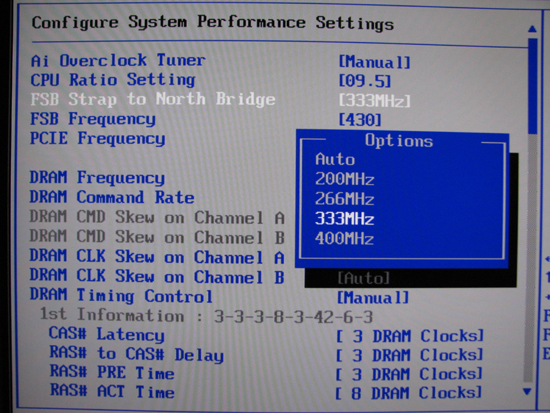
The ASUS Rampage Formula comes with official FSB1600 support, a feature attached to the use of the upcoming X48 chipset release. Those that want to use the next Intel Core 2 Extreme, the QX9770, will need to buy a board built around X48 if they want a platform validated for 400MHz FSB operation. We found the Rampage required no additional MCH voltage when running at this FSB setting.
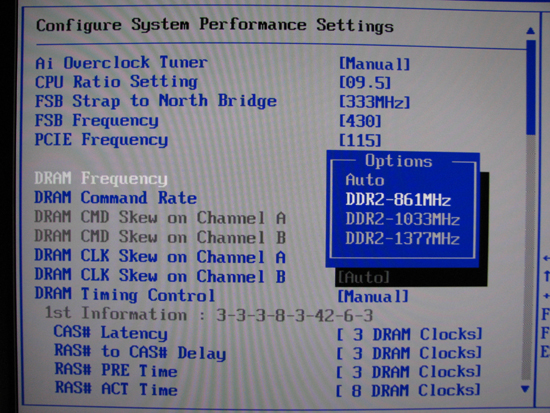
The standard compliment of DDR2 dividers is included in the Rampage Formula's BIOS. We will go into more detail about these later in the review. In any case, even with the fastest DDR2 available, we are not left wanting when it comes to options for pushing our memory.
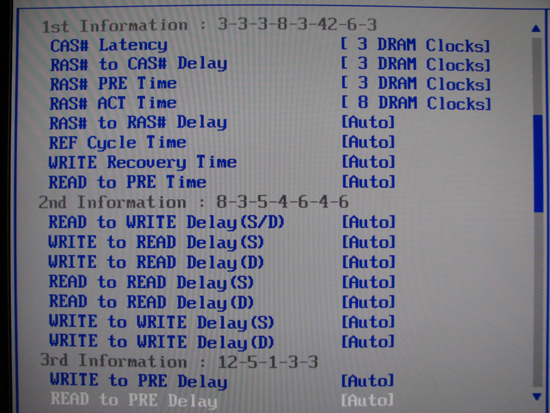
The BIOS includes adjustment options for all primary memory timings - 20 in all. Most of the time a majority of these can be set to "Auto" - ASUS' tuning is already quite good. However, experienced users and memory experts alike will enjoy the expansive level of control allowed.
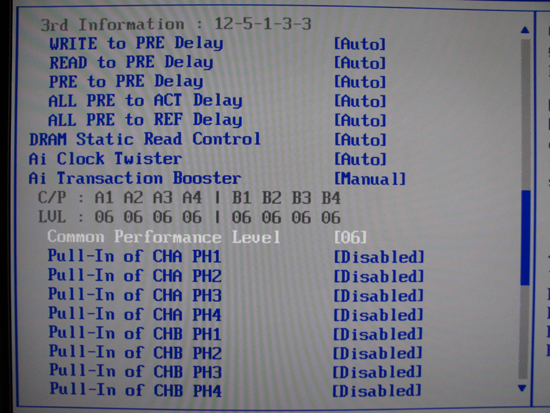
Here we can get a good look at what we consider the most significant change to the standard ASUS BIOS offering in years. "Common Performance Level", more correctly known as MCH Read Delay (tRD), allows the user to specifically establish a desired value, something that was not entirely possible in the past. Earlier versions of "Ai Transaction Booster" only allowed the user to apply an offset, which made controlling tRD difficult when the base value was unknown.
Additionally, each FSB bus cycle "phase" for each channel can be further manipulated. "CHA" and "CHB" refer to the two independent memory channels in a dual-channel memory configuration. Installing only one memory DIMM, or certain combinations of mismatched memory module pairings across all four expansion slots, results in the motherboard defaulting to single-channel operation; otherwise there are two memory channels in operation, which enhances overall system performance. The number of phases per channel depends on the memory divider in use (each channel will always have the same number of channels though) - a 3:2 memory divider has two phases, 4:3 has three, and 8:5 has five, for example. We will explore the theory behind this truth shortly.
Setting a single channel/phase "Pull-In" to enabled has the effect of lowering that particular phase's associated tRD value to one below the Common Performance Level (the "base" tRD). Leaving the setting disabled leaves the phase unadjusted, in which case it is the same as the base tRD. Much like memory timings, lower tRD values bring greater performance. As we will see, these settings primarily allow users to squeeze out any unclaimed performance benefit possible with the current tRD when the next "lower" Common Performance Level is unachievable. Do not feel as though you need to understand what all of this means right now, as we will cover all of this and much more in excruciating detail soon enough.
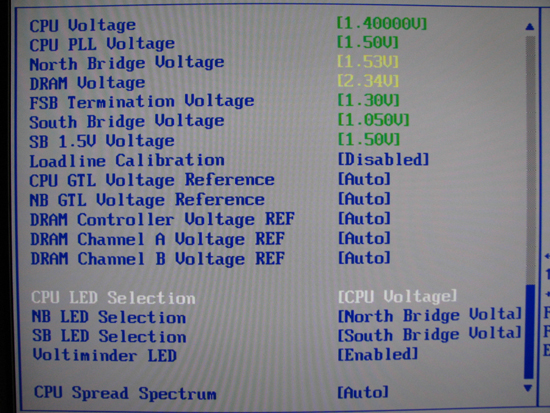
With no less than seven onboard voltage adjustments, the Rampage Formula is a tweaker's dream come true. Because ASUS motherboards do make a habit of "adjusting" some of these values automatically at times, we recommend you manually set all voltages to the bottom of their ranges unless otherwise required. This best practice just makes good sense and ensures nothing receives more voltage than intended by the user. Again, we must also strongly caution against the use of "Loadline Calibration." We recommend you leave this option disabled, especially when installing a 45nm CPU.
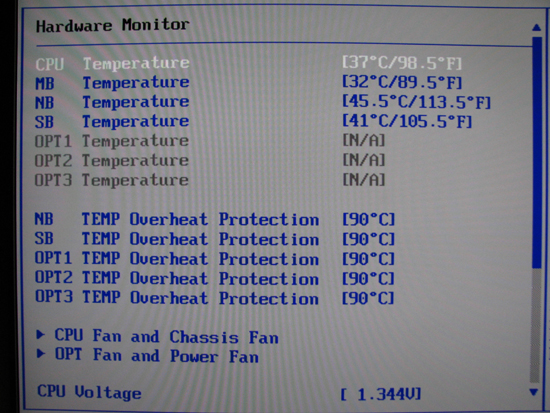
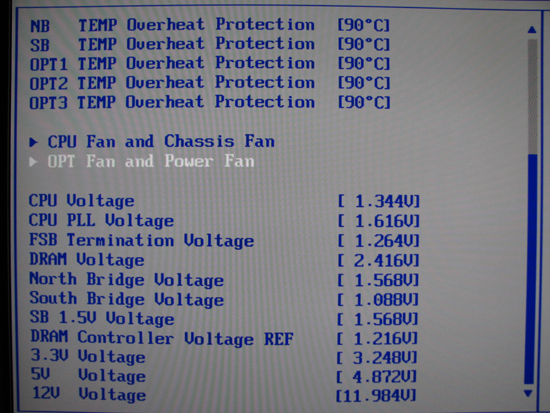
ASUS' implementation of their in-BIOS hardware monitor is extremely informative. You can simultaneously check temperatures for the CPU, motherboard (PWM), Northbridge (NB), and Southbridge (SB) as well as quickly review the effect that prior voltage adjustments had on actual voltage levels. Although we found most reported voltages were fairly accurate, obtaining the most precise readings possible still requires the use of a digital multimeter (DMM).
Regarding voltages, we found two concerns worth mentioning. Firstly, the reported CPU PLL voltage appears to be non-functional as it always reads the same, regardless of setting. Second, like many other ASUS offerings the motherboard consistently overvolts the memory by 0.08 ~ 0.10V. We do not see any real problem with this, as long as the user is aware it's happening.










73 Comments
View All Comments
poohbear - Friday, January 25, 2008 - link
one thing i liked about some of the recent high end mobo releases was the inclusion of an onboard wi-fi chip on a desktop mobo, but this mobo seems to be lacking that. i mean, they threw in everything but the kitchen sink, why not include wi-fi?:(TheDoc9 - Friday, January 25, 2008 - link
One of the best I've read here, definitely one of the best on over clocking I've ever read. It takes it to the next level, reminded me of how a body builder friend of mine schedules and calculates his workouts, calories, and entire life to be the best he can be. Hope to see more like this one in the future.jimru22 - Friday, January 25, 2008 - link
The article references the use of an Intel Extreme processor with adjustable multiplier. I'm planning on building a system hopefully anchored by the Asus Rampage Formula and a Intel Q9450 with locked 8X multiplier. Based in the charts, it seems to me that in order to run the Q9450 (333 MHZ) at 3.6 MHZ a 450 MHZ FSB is required. Therefore in this case, a tRD of 6 / Trd 13.3ns is the optimum value. Is this correct?kjboughton - Friday, January 25, 2008 - link
You would be correct. Processors with lower maximum multipliers present somewhat of a challenge when selecting the best memory configuration. In this case the 8x multiplier forces a higher than normally desired FSB, which is one of the many benefits of owning an Extreme processor (no such limitation). As such, the next best option, and the first choice for you, would be to go to 450MHz FSB and set a tRD of 6. Although this might not be completely ideal (we like to stick with 400MHz) your results will without a doubt be within a few percent of real-world performance at 400MHz FSB and a tRD of 5. Yet another reason why the Extreme line of processors are worth their price.Odeen - Saturday, January 26, 2008 - link
I'd like to differ on that.. As someone who first discovered overclocking during the Celeron 300A days, where a budget chip could run at 50-60% faster than its stock speed, and deliver higher performance than a $400 (at release time) Pentium III 450MHz, all without overstressing the rest of the platform (i.e. with bog-standard FSB and memory speed) I view overclocking as two ratios:Maximum attainable clock speed / original clock speed. 3:2 is the minimum ratio that isn't depressing to see booting up.
Cost of equivalent performance from a processor w/o overclocking / cost of actual processor. In the case the ratio was 4:1. Some of the best-case scenarios (like the very last 300A's being 100% overclockable to 600mhz), the ratio can be 6-7:1.
The Black Edition CPU's fail both value tests tests, because they are typically ONLY available at the fastest speed grades. Therefore, they are unlikely to reach a 30% overlock, never mind the requisite 50. And, being the most expensive SKU in the class combined with the lackluster overclock potential means that they are unlikely to outperform a processor that costs 4x as much (even an imaginary SKU that fits on the price-performance regression line of the class).
That said, if the Wolfdale E8190 is $130 and Intel somehow offers an "enthusiast edition" of it for $180 (that is, an edition for true enthusiasts, who want to extract the maximum bang for their buck), I would get one - the unlocked multiplier would make overclocking less of a "platform" issue (i.e. "how fast will the chip go until my motherboard peters out") and more of "how fast will this particular chip go period". I can definitely get behind that.
jimru22 - Friday, January 25, 2008 - link
Thank you Kris for the outstanding article as well as your response.Kind regards,
Jim
Orthogonal - Friday, January 25, 2008 - link
What are the chances someone could whip up an Excel Macro to incorporate all these inputs, equations and graphs for easy computation of optimal settings for a given CPU and Memory configuration.kjboughton - Friday, January 25, 2008 - link
Already exists, although you'll have to sweet-talk me into releasing the file. Seriously though, the Excel spreadsheet makes choosing the right settings downright simple.Orthogonal - Friday, January 25, 2008 - link
Fair enough, pretty please!Well maybe there could atleast be a web applet on the site or something of the sort. That would be killer.
LoneWolf15 - Friday, January 25, 2008 - link
Just one thought...IMO, no "Board Layout" portion of a review is complete without a picture of the port cluster on the back of the board.